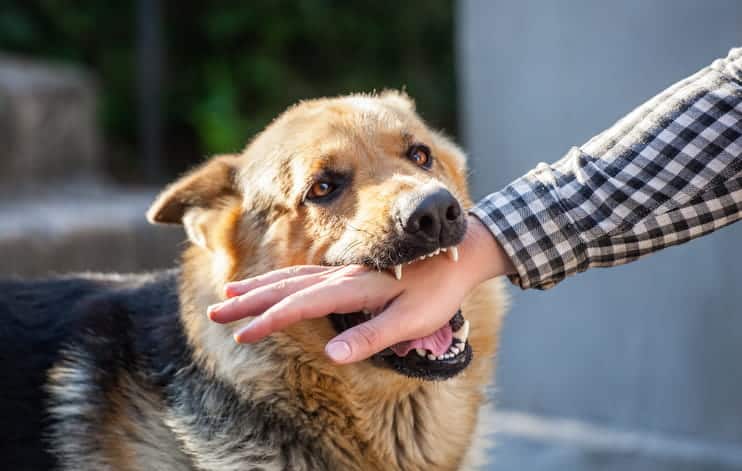Each year, the United Kingdom sees a significant number of animal bites, impacting millions of individuals.
While animal bites are often associated with the fingers of the dominant hand, they can occur across various parts of the body, including the head, neck, and other regions.
These incidents pose not only physical risks but also potential complications such as infections and long-term health issues.
Understanding the prevalence and patterns of animal bites in the UK is crucial for implementing effective prevention and treatment strategies to safeguard public health.
Symptomes
Symptoms stemming from animal bites encompass a spectrum of injuries, varying from tissue trauma to the risk of infection if the skin is punctured.
Tissue trauma may lead to limb or digit deformities, loss of function, numbness, and localised pain.
Concurrently, signs of infection can manifest with the discharge of pus, heightened pain, noticeable redness encircling the puncture site, increased swelling, and warmth in the affected area.
In severe cases where deeper structures are affected, individuals may experience restricted mobility, sensory deficits, and potentially even nerve damage.
It’s essential to promptly address these symptoms to prevent further complications and ensure proper healing.
Key Steps for Assessment and Evaluation
- Gather details about the incident, including timing, location on the body, and the involved animal.
- Inquire about the biting animal and its rabies vaccination status, if known.
- Focus on symptoms like fevers, chills, wound drainage, redness, or swelling, especially if time has passed since the bite.
- Inspect the injured area for signs of infection, such as redness, drainage, and swelling.
- Assess functionality to ensure no loss of sensation, movement, or strength in the affected area.
- Perform imaging tests like X-rays to assess potential bone or joint injuries.
- Recommend further tests such as blood tests, MRI scans, or ultrasound if infection is suspected for better visibility of infections compared to X-rays.
Treatment Guidelines for Animal Bites:
Immediate First Aid:
- Refrain from putting the bitten area in your mouth to prevent bacterial contamination.
- Clean the wounds with soap and water or sterile saline.
- Apply pressure with a clean cloth or, better, with a sterile gauze if bleeding is severe.
- Elevate the affected body part to aid in reducing bleeding.
- In cases of severe and uncontrollable bleeding, consider applying a temporary tourniquet.
- Splint the area if there’s evidence of deformity, indicating a possible fracture, for comfort.
- Report the bite incident to the local public health department for further actions, including monitoring the animal for rabies symptoms.
Superficial Wounds:
- Wash the area meticulously with soap and water or sterile saline.
- Dress the clean wound with sterile gauze.
- Seek immediate medical attention, such as antibiotics, for further examination and potential treatment.
- Ensure tetanus vaccination is up to date; consider rabies prophylaxis if necessary.
Severe Wounds:
- Physicians may opt to leave the wound open for drainage to prevent infection.
- Facial wounds may be cleansed thoroughly and closed.
- Diagnostic tests like X-rays, blood tests, ultrasound, or MRI scans may be ordered.
- Consultation with specialists such as orthopaedic, plastic, or hand surgeons may be necessary for complex injuries.
Treatment modalities for specific injuries:
- Bone: Surgical debridement and fixation with pins, plates, or screws may be required.
- Tendon: Timely repair by a surgeon may restore function.
- Ligament: Prompt attention and possible surgical intervention may be necessary.
- Blood vessel: Urgent surgical attention may be needed to preserve or restore blood flow.
- Nerve: Prompt evaluation by a specialist is essential; repair may be possible, but recovery can be prolonged with potential permanent loss of function.
Navigating Consequences After Animal Bites
The severity of the injuries sustained influences outcomes following animal bites.
Minor, superficial bites may result in minimal consequences, often leaving behind a scar. When uncomplicated by infection, these wounds typically require minimal treatment.
Severe bites can lead to long-term or permanent complications, including loss of sensation or impaired function.
Infections resulting from animal bites can have profound implications, potentially becoming life-threatening. Tetanus and rabies are particularly concerning infections that pose limb and life-threatening risks.
Prompt and aggressive treatment is essential to ensure optimal outcomes of suspected infection.
Therefore, seeking immediate medical attention following an animal bite is crucial to mitigate potential complications and achieve the best possible prognosis.

